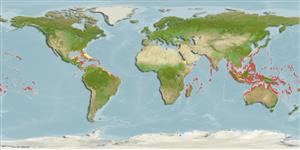Common names from other countries
Environment: milieu / climate zone / depth range / distribution range
Ecologia
; intervalo de profundidade 0 - 20 m (Ref. 4). Tropical; 33°N - 36°S, 97°W - 135°W (Ref. 4)
Indo-Pacific and Western Atlantic.
Length at first maturity / Tamanho / Peso / Idade
Maturity: Lm ? range ? - ? cm Max length : 20.0 cm TL macho/indeterminado; (Ref. 4)
It has lengths of 20 cm, maximum total length; between 2 and 9, carapace length (Ref. 4). Taken at depths from 0 to 20 m, in coral or stone reefs with a sandy bottom. It is nocturnal and in the daytime hides in crevices, sometimes in small groups (Ref. 4). Also on rubble (Ref. 97531). Scyllarids are commonly considered to be opportunistic omnivorous (Ref. 106411). Aquarium observations indicate that they may open bivalves (Ref. 102680).
Life cycle and mating behavior
Maturidade | Reprodução | Desova | Ovos | Fecundidade | Larvas
Members of the order Decapoda are mostly gonochoric. Mating behavior: Precopulatory courtship ritual is common (through olfactory and tactile cues); usually indirect sperm transfer.
Holthuis, L.B. 1991. (Ref. 4)
Status na Lista Vermelha da IUCN (Ref. 130435)
Status no CITES (Ref. 108899)
Not Evaluated
Not Evaluated
Uso pelos humanos
Pescarias: espécies comerciais
| FishSource | Sea Around Us
Ferramentas
Mais informação
Idade/Tamanho
Crescimento
Comprimento-peso
Comprimento-comprimento
Morfologia
Larvas
Abundância
Fontes da internet
Estimates based on models
Preferred temperature
(Ref.
115969): 25.6 - 29.3, mean 28.1 (based on 3695 cells).
Vulnerabilidade
Low vulnerability (10 of 100).
